Slade's Morgue:
Death's Door

Cemetery Dance edition of DEATH'S DOOR
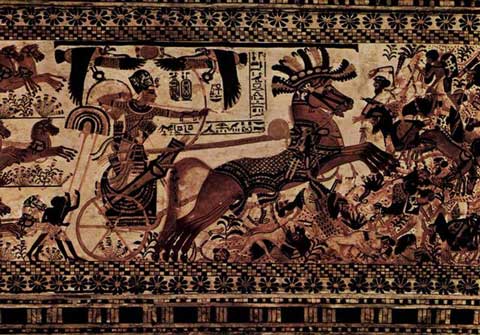
Tutankhamun at war
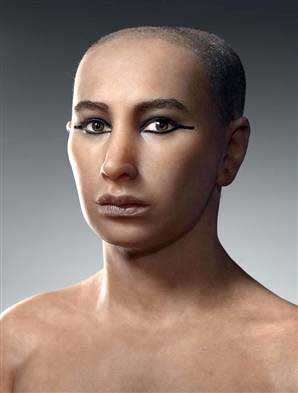
Tutankhamun in life

Tutankhamun's mummy

King Tutankhamun's golden funeral mask
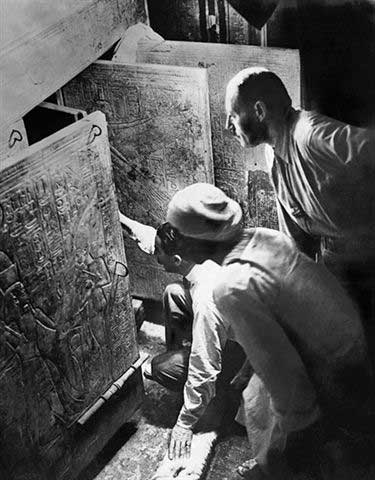
Archaeologist Howard Carter enters King Tut's Tomb, 1922
DEATH'S DOOR is Michael Slade's Egyptian mummy thriller. The return of Mephisto. The novel stands alone. You needn't have read Mephisto's introduction in BURNT BONES. Here's the story behind it.
Of all the ancient civilizations you studied in school, which one most captured your imagination? For Slade, it was Egypt...followed closely by Rome. In his schools, classical history was taught in Grades 4 and 7 (ages 9 and 12).
Slade's fascination with Egypt began with Boris Karloff as the Mummy.

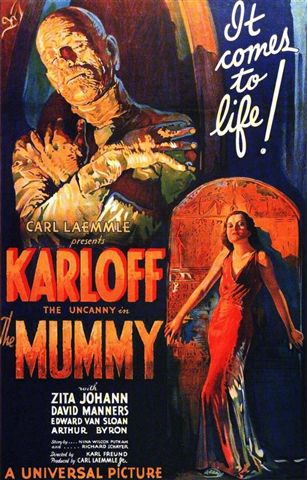
Slade saw his first mummy in the local museum on a Grade 3 field trip. After reading the Sherlock Holmes stories by Sir Arthur Conan Doyle, Slade moved on to "Lot No. 249" (1892). In it, an Oxford student uses Egyptian magic to reanimate an Egyptian mummy and send it out to kill people against whom he holds grudges. After reading Bram Stoker's DRACULA, Slade sought out THE JEWEL OF SEVEN STARS (1903). In it, an archaeologist attempts to revive Queen Tera, an Egyptian mummy.
When he was 12, Slade devoured every Lovecraft story (see GHOUL). In 1924, two years after the unearthing of King Tut's Tomb, H.P. Lovecraft was asked to ghost-write a story for magician and escapologist Harry Houdini. "Imprisoned with the Pharaohs" ("Under the Pyramids") appeared in WEIRD TALES.

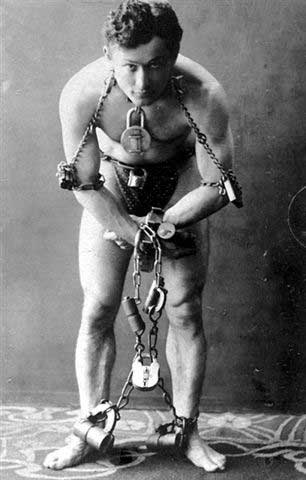
Later in life, Slade read a letter that HPL wrote to a fellow writer:
"It seems that once Houdini was in Cairo with his wife on a non-professional pleasure trip, when his Arab guide became involved in a street fight with another Arab. In accordance with custom, the natives decided to fight it out that night on the top of the Great Pyramid; and Houdini's guide, knowing the magician's interest in exotic oddities, invited him to go along with his party of seconds and supporters. Houdini did, and saw a tame fistic encounter followed by an equally mechanical reconciliation. There was something off-color and rehearsed about it all, and the wizard was hardly surprised when suddenly the frame-up was revealed, and he found himself bound and gagged by the two Arabs who had faked the combat. It had all been prearranged - the natives had heard of him as a mighty wizard of the West, and were determined to test his powers in a land where wizards had once ruled supreme. Without ceremony they took him to an aperture in the roof of the Temple of the Pharaohs where a sheer drop of fifty-three feet brings one to the floor of the nighted crypt which has but one normal entrance - a winding passage very far from this well-like opening. Producing a long rope, they lowered him into this abode of darkness and death and left him there without means of ascent - bound and gagged amidst the kingly dead, and ignorant of how to find the real exit. Hours later he staggered out of that real exit, free, yet shaken to the core with some hideous experience about which he hesitates to talk. It will be my job to invent the incident, and give it my most macabre touches. As yet, I don't know how far I can go, since from a specimen Houdini story which Henneberger sent me I judge that the magician tries to pass off these Munchausens as real adventures. He's extremely egotistical, as one can see at a glance. But in any case, I guess I can weave in some pretty shocking things...unsuspected lower caverns, a burning light amidst the balsam'd dead, or a terrible fate for the Arab guides who sought to frighten Our Hero."
When he was 12, Slade also ripped through Agatha Christie (see RIPPER). In 1924 - again, two years after the unearthing of King Tut - Christie published "The Adventure of the Egyptian Tomb" in POIROT INVESTIGATES. In it, inexplicable deaths surround the opening of a Tutankhamun-like tomb: heart attack, blood poisoning, suicide by gun. The story was inspired by alleged real-life events.
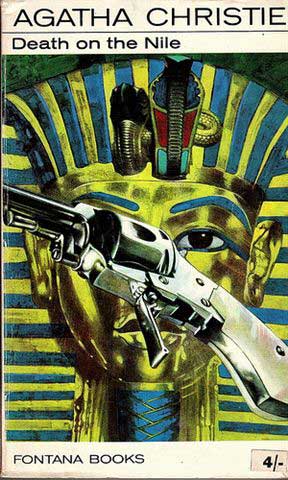
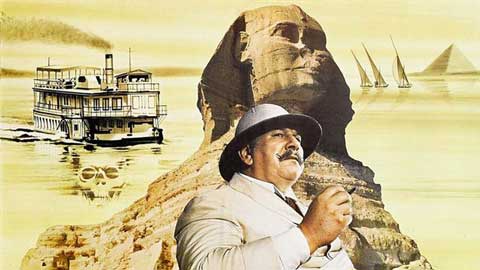
Movie poster for Christie's DEATH ON THE NILE
When Tutankhamun, aged 19, died some 3,300 years ago, his successors tried to erase all record of the boy-king from history. Convinced that Tut's missing tomb could be found in the Valley of the Kings, Howard Carter spent five years searching that necropolis on the west bank of the Nile. On November 4, 1922, Carter's workmen discovered a step cut into the rock hidden by debris discarded during the building of the tomb of Ramesses IV. Digging further, they unearthed a sealed door bearing the name Tutankhamun.
Having brought a yellow canary to Egypt, Carter went home that evening to find the bird eaten by a cobra. See the cobra on the brow of Tut's funeral mask above? It represents the Green One: the protector goddess Wadjet. Carter's servant told him, "The pharaoh's serpent ate the bird because it led us to the hidden tomb! You must not disturb the tomb!"
Scoffing at such superstition, Carter sent a telegram to his financier, Lord Carnarvon, in England. On November 26, with Carnarvon watching, the archaeologist broke into Tutankhamun's tomb. Holding a candle, he leaned in for a look. Behind him, Carnarvon asked, "Can you see anything?" Carter answered, "Yes, wonderful things."
The tomb was intact and offered up an amazing collection of treasure. The wealth surrounded a stone sarcophagus containing three gold coffins, each within another. Inside the inner coffin, Carter found Tut's mummy.

Carter with Tut's mummy
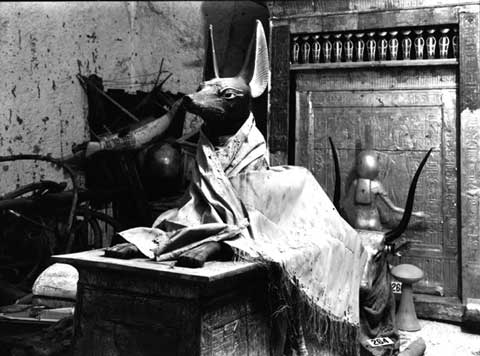
Anubis, the God of Death and Embalming, guards Tut's Tomb
Finding Tut's Tomb caused a media frenzy. Rumors ran rife. At one point, it was wrongly reported that a curse was engraved at the entrance: Death Shall Come on Swift Wings To Him Who Disturbs the Peace of the King.
A few months after the tomb was opened, tragedy struck. A mosquito bit Lord Carnarvon on the cheek. He slashed the bite while shaving, the wound became infected, and blood poisoning killed him in April 1923. At the moment of his death, it was said, all the lights went out in Cairo. Back home in England, his favorite dog, Susie, suddenly howled and dropped dead.
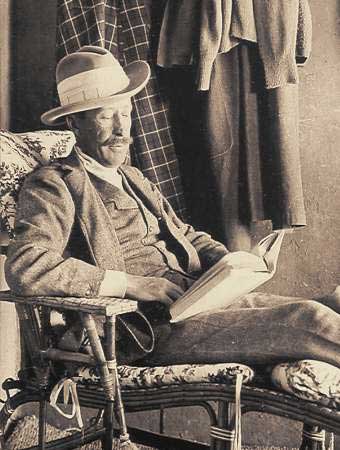
Lord Carnarvon
Conan Doyle, the creator of Sherlock Holmes, believed in the occult. When he announced that Carnarvon's death could have been caused by a "pharaoh's curse," the press went wild. Deaths by the dozen were attributed to King Tut. Stranger still, the unwrapping of Tut's mummy in 1925 revealed a wound on the left cheek in the same location as the insect bite that killed Carnarvon. Carter, however, who logically should have been first to succumb to the Curse of the Mummy, didn't die until 1939.

Carter disturbing King Tut
In 1977, Slade journeyed to Egypt. After dark, he checked into the Mena House Hotel, a hunting lodge converted in 1885. Conan Doyle was a guest in 1894.

Mena House Hotel
Come morning, Slade threw open the drapes of his room to this.
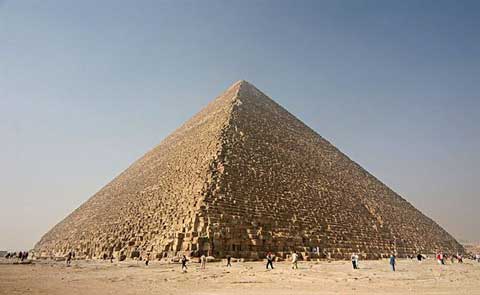
(photo by Nina Aldin Thune,
licensed copyright)
Slade has a behavioral disorder that he calls his "imp of the Perverse." It manifests when he travels. The disorder compels him to seek "authentic experience," which invariably involves breaking the rules. (See the Great Wall of China in CUTTHROAT; the lion and the cobra in ZOMBIE/EVIL EYE; and the cannibal cave in BED OF NAILS.) On his trip to Egypt, Slade yearned to experience this.
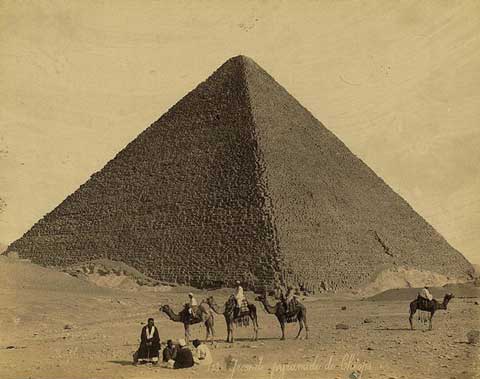
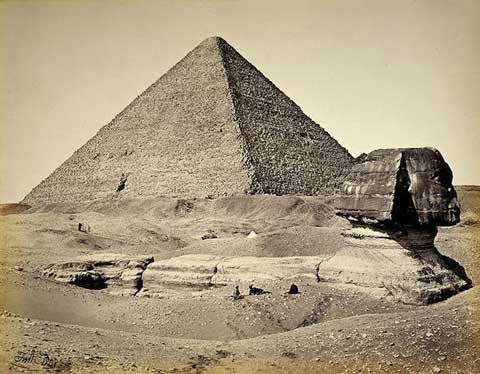
The Great Pyramid and the Sphinx in 1858
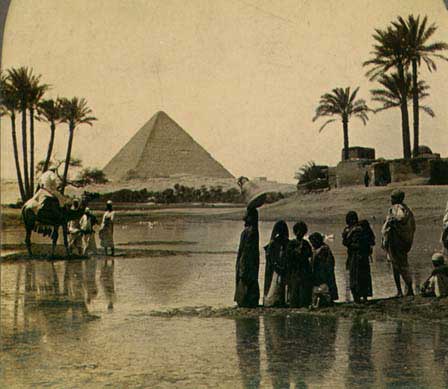
The Great Pyramid in the 19th century
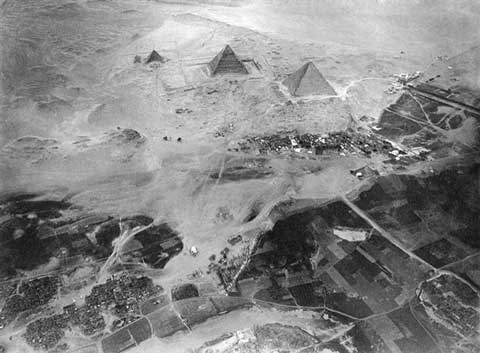
The Pyramids from a balloon in 1904
To strip the scene of modern tourists and time travel into the past, Slade wandered into the desert. There, he snapped this photo of the Pyramids with just an Arab horseman.

In fact, the Arab horseman had spotted Slade as a tourist who might be willing to part with American dollars (the currency of seasoned travelers: accepted everywhere) for an "authentic experience." For $5, Slade swung into the saddle, and got to fantasize that he was Lawrence of Arabia, galloping in from the desert with nothing before him but sand...until suddenly, the Great Pyramid spiked up from the dunes.
So, what have we here? An intrepid explorer? Or a damn fool?
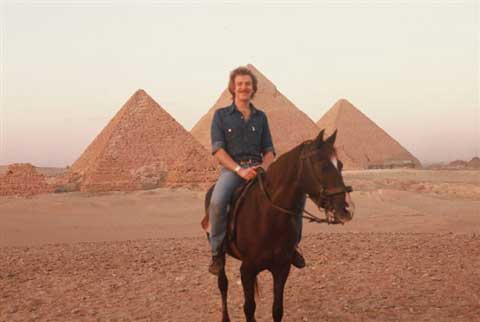
Imagine you are Slade, facing the Pyramids:
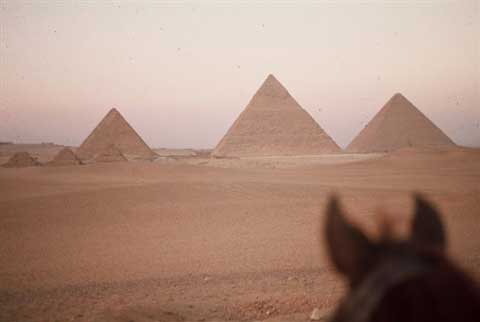
You've just paid the Arab horseman five of these:

Like that little devil you see in cartoons, the Imp of the Perverse is perched on your left shoulder, whispering in your ear. The Imp says, "Houdini." So you remember Lovecraft: "In accordance with custom, the natives decided to fight it out that night on the top of the Great Pyramid; and Houdini's guide, knowing the magician's interest in exotic oddities, invited him to go along..." Do you sense the compulsion that welled up in Slade? "I wonder what it's like," he thought, "to be the All Seeing Eye."
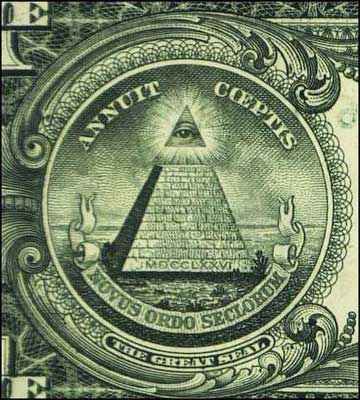
Of the Seven Wonders of the Ancient World...
The Great Pyramid of Giza
The Hanging Gardens of Babylon
The Statue of Zeus at Olympia
The Temple of Artemis at Ephesus
The Mausoleum of Maussollos at Halicarnassus
The Colossus of Rhodes
The Lighthouse of Alexandria
...only the Great Pyramid survives.
That alone is reason to climb it. As Sir Edmund Hillary said of why he climbed Mount Everest: "Because it's there."
The Great Pyramid was built around 2560 B.C. That's about 1,300 years before the reign of King Tut. For over 3,800 years, the Great Pyramid was the tallest manmade structure in the world. Alexander the Great stood before it. And so did Napoleon.
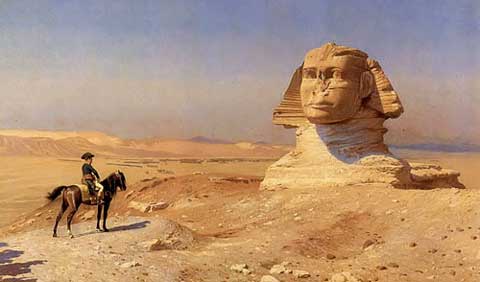
NAPOLEON AND THE SPHINX, by Jean Gerome, 1862
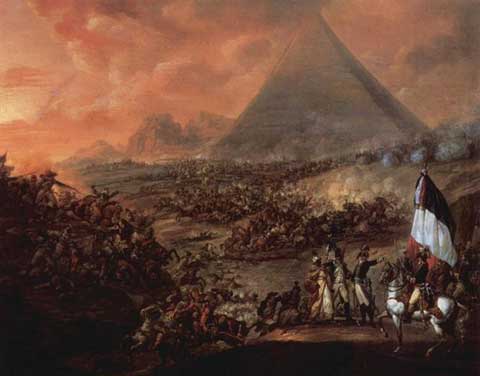
THE BATTLE OF THE PYRAMIDS, by Francois-Louis-Joseph Watteau, 1798 - 1799
Before the Battle of the Pyramids on July 21, 1798, Napoleon addressed his troops: "Soldiers, from the heights of these Pyramids, forty centuries look down on us!" So that's another reason to climb. "Man fears Time," it is said, "yet Time fears the Pyramids."
But first, some perspective.
Here's the Sphinx standing guard before the Pyramid of Khafre, the second tallest. Note how the apex retains its smooth casing stones.
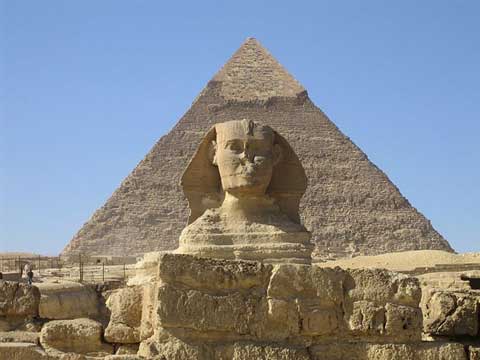
(photo by Ian Sewell,
licensed copyright)
Here's the Sphinx from the side. Note the size of the people.
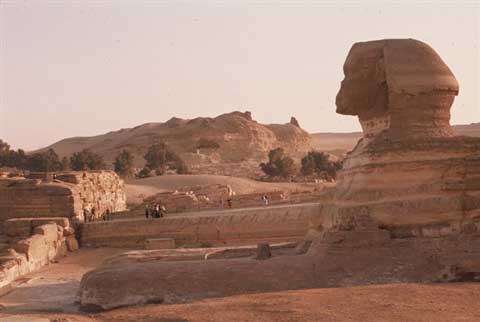
The Great Pyramid has over 200 tiers of stone blocks. The blocks vary in height. Some rise five feet.
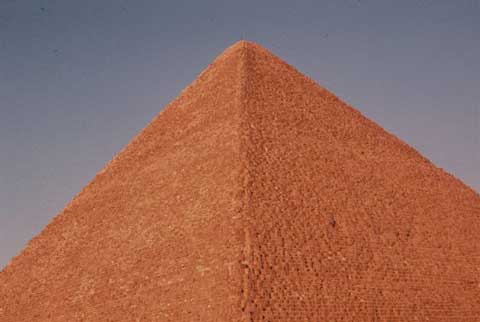
This photo of the Australian Imperial Force was snapped in 1915. Within months, a third of these men would die at Gallipoli.
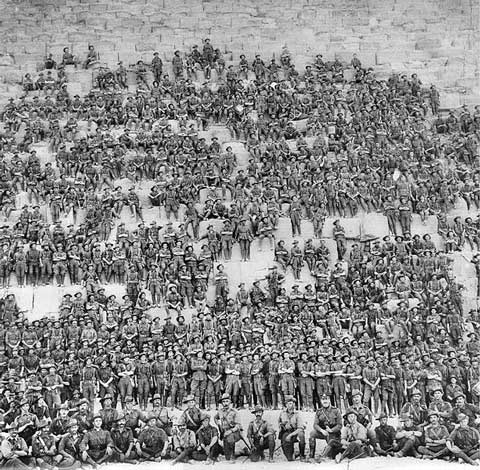
Slade took this photo. Note the height of the blocks.

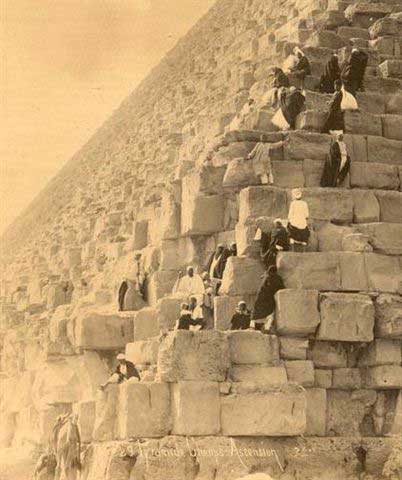
The climb in 1880
Here's the view from the bottom. Are you ready to climb? It's now forbidden to scale the Great Pyramid, so come along with Slade.
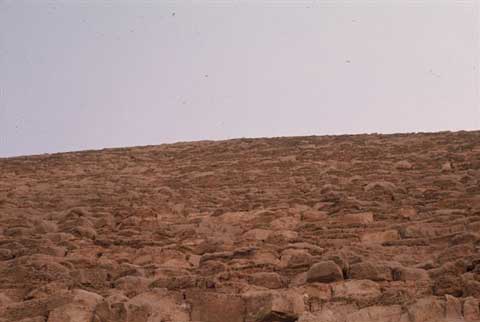
The dry heat was brutal as Slade began to climb. It leached him of sweat, and soon his canteen was empty. Every block required a pushup to elevate his knee, followed by crawling up onto the flat of the stone, then gaining his feet. It was soon evident how out of shape he was. His arms got weaker and his legs turned rubbery. But finally, hours later, he made it to the top.
Gaze down on Khafre, stunted below...

(Great Pyramid apex photos by Slade)
...and you want to shout, "Made it, Ma! Top of the world!" like James Cagney in WHITE HEAT (1949):

Tower above the now puny Sphinx and the dot-like people...

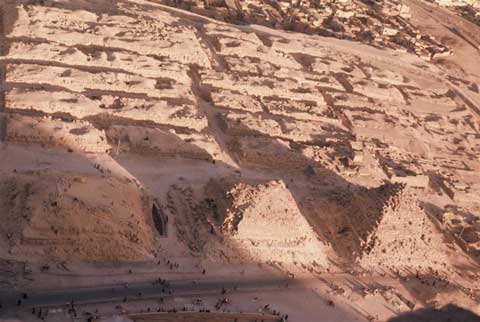
...and you recall a book you read as a boy:

You want to beat your chest and let out a jungle yell. King Kong atop the spire of the Empire State Building.
Then the euphoria wears off, and you gaze down the steep side of the Great Pyramid...
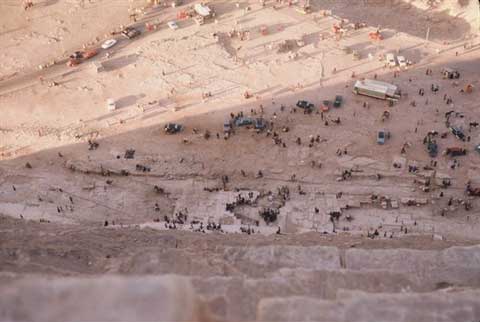
...and you say to yourself, "Okay, Houdini, how do we escape from this?"
Do you descend face out, or face in? One false step on wobbly, exhausted legs, one trip, snag, or stubbed toe, and you'll bounce, bounce, bounce, all the way to the bottom. Tomorrow, the Cairo papers will report the death of the intrepid explorer under the headline DAMN FOOL PLUMMETS FROM PYRAMID.
Such are the dangers Slade will face to bring verisimilitude to his readers!
As you struggle down the side of the Great Pyramid, you grasp that hidden beneath your feet are once secret passages burrowing to the heart of this mysterious Wonder of the Ancient World...

(diagram by Jeff Dahl, licensed copyright)
...and that in the King's Chamber - long ago stripped of wealth by robbers - squats the empty red granite sarcophagus of the pharaoh, King Khufu (Cheops in Greek).
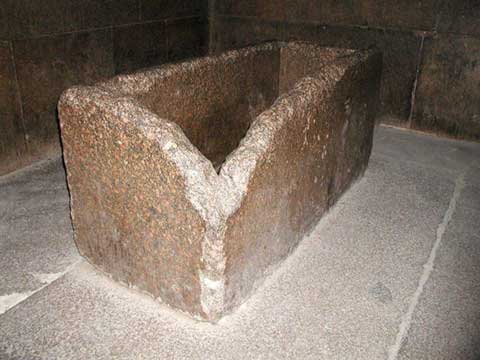
Sarcophagus in the King's Chamber
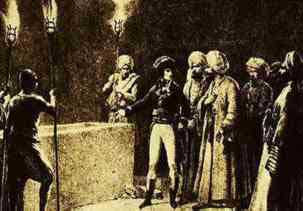
Napoleon in the King's Chamber
The Great Pyramid was built for a crucial reason: to preserve the mummified remains of the Egyptian pharaoh.
Why?

Anubis with an embalmed pharaoh
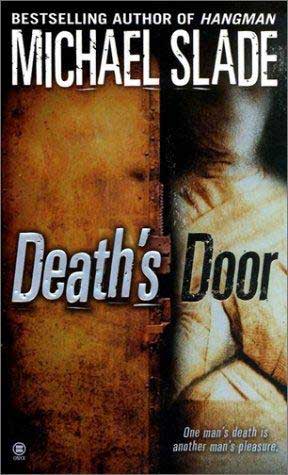
American edition of DEATH'S DOOR
The photos pinned to the Strategy Wall in Chief Superintendent Robert DeClercq's office are of surgically mutilated corpses dumped throughout the West Coast's San Juan and Gulf Islands. The Mounties of Special X and San Juan County Sheriff's deputy Jenna Bond are up against cunning psychos creating human monsters. And then there's the perfectly preserved Egyptian mummy stolen in England by a heist that incinerates eight security guards, later smuggled into North America by the shooting deaths of customs agents. Mixed in with these macabre events are a local porn king, a made-to-order snuff film producer, a necrophilic killer dubbed the Undertaker, and a renegade plastic surgeon to aging Hollywood stars. The race is on to piece the puzzle together before the cops on both sides of the border lose their kidnapped own. But the worst threat comes from Mephisto: a madman bent on diabolic revenge against DeClercq, a megalomaniac plotting to bring the world to the brink of Death's Door.
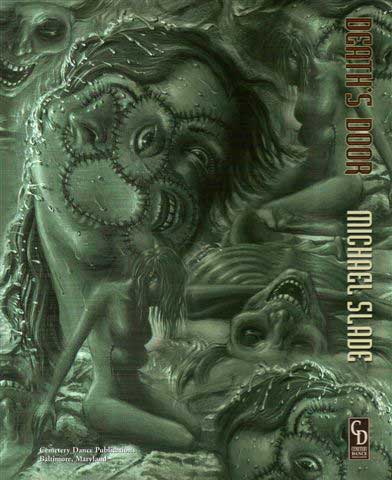
(illustration by Alan M. Clark)
The Egyptians believed the death of the body did not mean an end to life. When the body died, the soul set free three spirits: the Ba, the Ka, and the Akh. The Ba could haunt the land of the living as a ghost. The Ka - the spirit of life - could not leave the tomb. Molded by Khnum, the creator god, at the moment of conception, the Ka was an exact replica of the body. The Akh - immortality - journeyed to the door of the afterlife, where Anubis weighed the heart of the deceased against a feather. Pass that test and the Akh would enter Death's Door and live forever in Egyptian heaven. But there was a hitch.
The Second Death was the worst fate that could befall an Egyptian. Perishing in the land of the dead meant total obliteration. The Second Death was caused by loss of all memory of the deceased by the living, and that was caused by destruction of the corpse. To survive, the Ka in the tomb had to be able to return to what was once its physical host. And because the Ka was an exact replica of the body, it could recognize only its own form. If the corpse should decay beyond recognition, the Ka would die. If the Ka died, so did the Ba and the Akh. Therefore, to keep from dying the Second Death in the land of the dead, it was imperative that the corpse survive in recognizable form...and that, Virginia, is why the Egyptians became master embalmers.
A mummy retains human form. And a pyramid provides an almost impregnable tomb.

Lady Rai, a well-preserved mummy
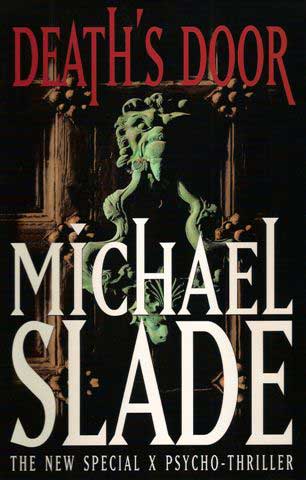
Knocking on DEATH'S DOOR, Canadian hardcover
Lord Ridding owns the most perfectly preserved mummy ever plundered from Egypt. The novel opens with Mephisto's henchman, Stopwatch, hijacking it during transport.

Detoured down an alley, the hearse stops for a red light. Detective Inspector Kim Rossmo, the inventor of Geographic Profiling, who appears as a real-life character in BURNT BONES, DEATH'S DOOR, and SWASTIKA, suggested using a thermal lance for the heist.

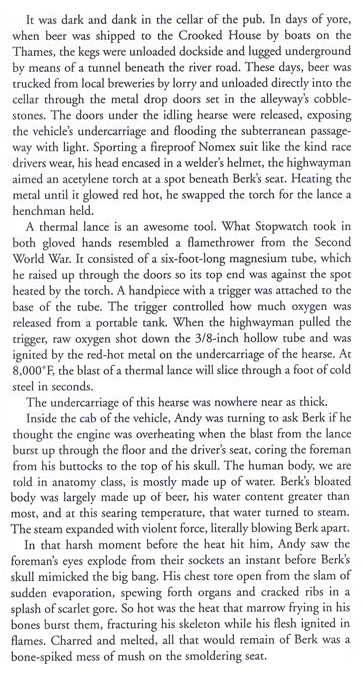

Abu Simbel from the air
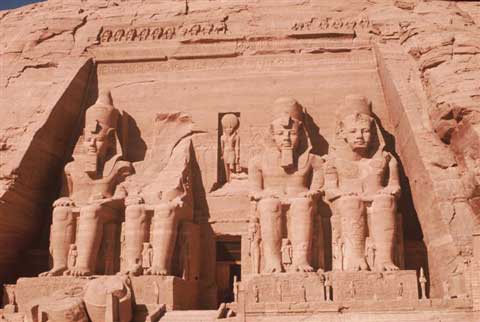
Abu Simbel from the ground
As a lasting memorial to himself, Ramesses II raised the huge statues at Abu Simbel. There'd be no Second Death for him, if he could help it. King Tut's successors tried to erase his memory, but his cartouche - an oval with a pharaoh's name in hieroglyphics - survived on a wall of dynasties. That's why Carter went hunting.

Door to Tut's Tomb
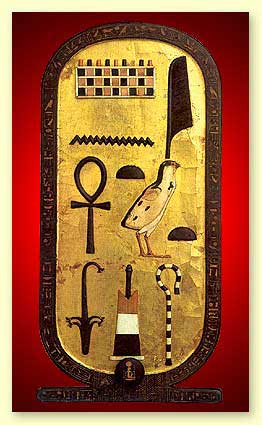
Tut's cartouche
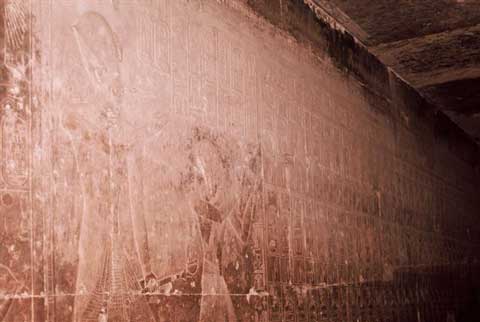
Wall of pharaohs' cartouches
The zoomorphic gods of Egypt fascinated Slade as a boy, and when he later ventured up the Nile, they were everywhere.
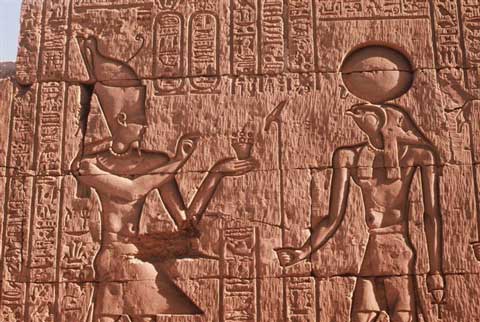
Falcon-headed Ra, God of the Sun
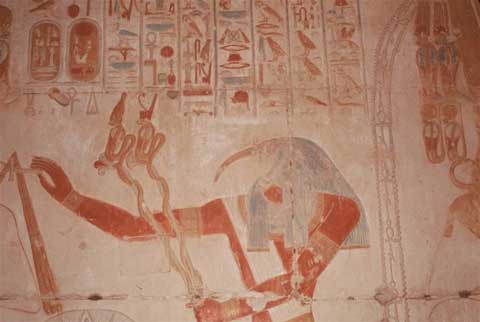
Ibis-headed Thoth, God of Wisdom

Hawk-headed Horus, God of the Sky and Protector of Pharaohs, wearing the crown of Egypt

Crocodile-headed Sobek, God of the Nile

Again, jackal-headed Anubis, Slade's favorite
The Sphinx forged the link in Slade's mind to THE ISLAND OF DR. MOREAU, the horrific novel by H.G. Wells.

THE SPHINX, by Fernand Khnopff, 1898
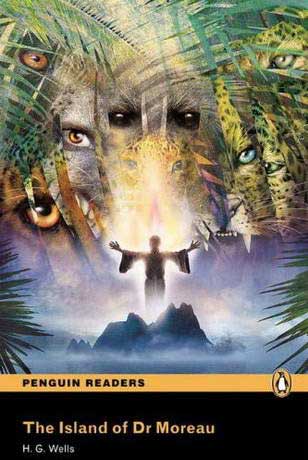
A shipwreck maroons Edward Prendick on THE ISLAND OF DR. MOREAU. He finds it populated by Beast Folk - half-human, half-animal - and suspects the zoomorphic creatures are the result of vivisection experiments on humans by the resident mad doctor Moreau in his "House of Pain." In fact, it's the reverse. Moreau is vivisecting animals into humans.

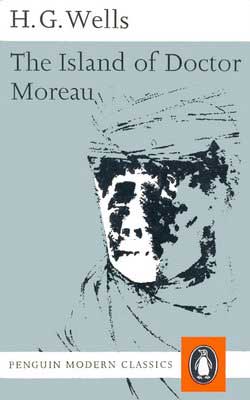
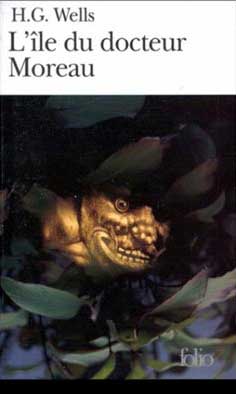
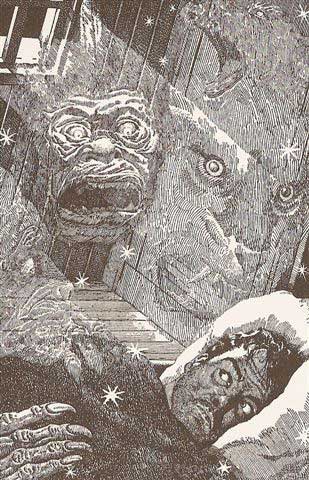
DREAMS OF THE BEAST MEN, by Stephen Lawrence
When Wells' Darwinian nightmare was published in 1896, it sparked a firestorm of controversy. Critics were unkind to the author of THE TIME MACHINE (1895), and later, THE INVISIBLE MAN (1897) and THE WAR OF THE WORLDS (1898). The Times of London called the novel "loathsome and repulsive. It is simple sacrilege to steep fair nature in the blood and antiseptics of the vivisecting anatomical theater." Wells himself said of his story, "THE ISLAND OF DR. MOREAU is an exercise in youthful blasphemy. Now and then, though I rarely admit it, the universe projects itself towards me in a hideous grimace. It grimaced that time, and I did my best to express my vision of the aimless torture in creation." The novel, of course, is now a classic.
In the 1990s, Slade was living on North Pender Island. The island inspired the first Mephisto thriller, BURNT BONES. In that book, the megalomaniac and malignant narcissist concocts a psychotic mass murder scheme out of his obsession with the secret of Stonehenge. Mephisto was conceived as the archnemesis of Special X, like Professor Moriarty is to Sherlock Holmes, and Ernst Stavro Blofeld is to James Bond, and the Deaf Man is to the 87th Precinct. So Slade was on the lookout for a plot to conjure the return of Mephisto.
One night, the movie channel showed ISLAND OF LOST SOULS, the 1932 film of THE ISLAND OF DR. MOREAU.
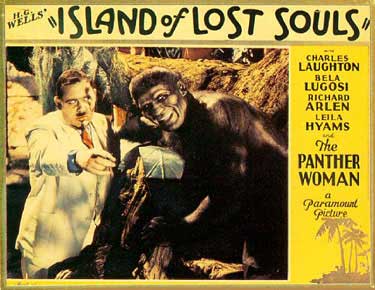
An image of Laughton as Moreau...
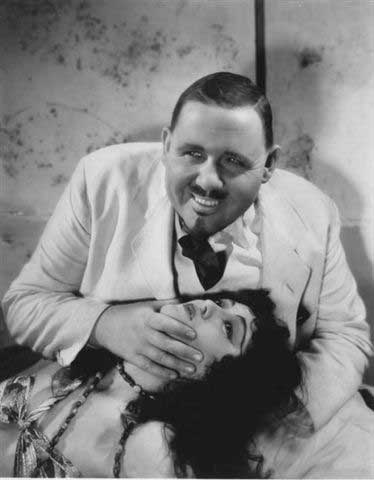
...led Slade to remember this:
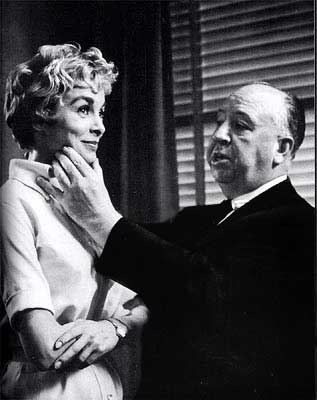
Sir Alfred Hitchcock and Janet Leigh
Slade was 13 when PSYCHO (1960) slashed across the screen. What a jolt! Psycho thrillers were changed forever. But as dark as the images were in the theater, the goings-on behind the camera were dark as well. Here's the story of the Hitchcock Syndrome.
Alfred Hitchcock was a tubby man who seethed with sexual frustration. He looked nothing like his leading men: Gregory Peck, Cary Grant, James Stewart. His role as director, however, allowed him to deify and fetishize his leading ladies. So he controlled every aspect, including their underwear.
Hitchcock was obsessed with ice queen blondes. Madeleine Carroll in THE 39 STEPS (1935). Ingrid Bergman in SPELLBOUND (1945). Grace Kelly in REAR WINDOW (1954). Doris Day in THE MAN WHO KNEW TOO MUCH (1956). Vera Miles in THE WRONG MAN (1956). Kim Novak in VERTIGO (1958). Eva Marie Saint in NORTH BY NORTHWEST (1959).
Though Hitch made them stars, one by one the women spurned him for other men. Bergman left for Italy to live with Rossellini. Kelly left to marry the Prince of Monaco. Vera Miles got pregnant before VERTIGO. Hitch clashed with Kim Novak, her replacement. When Audrey Hepburn - though not a blonde - backed out on the director and NO BAIL FOR THE JUDGE, his frustration exploded. From then on, blondes would not be idolized in Hitchcock films. They'd be torn apart.
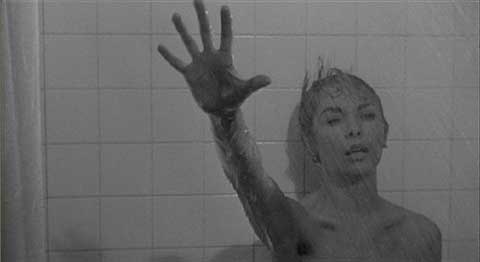
Janet Leigh in PSYCHO
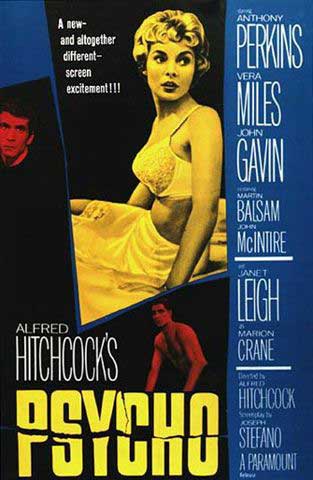
The shower scene in PSYCHO is rape with a knife. But at least it's fantasy. What Hitchcock did to Tippi Hedren in THE BIRDS (1963) was worse. The final avian attack saw her trapped in a room full of ravens, gulls, and crows tied to her with elastic bands. For days, the birds were thrown at her, and one almost pecked out her eye. Hedren suffered a breakdown. Rumor was Hitchcock shot the last day with no film in the camera.
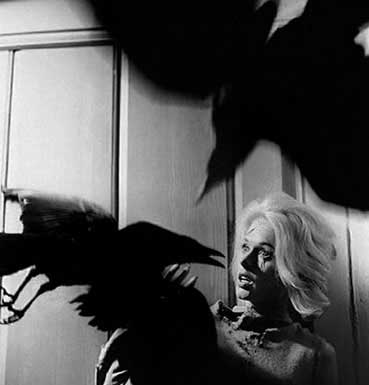
Tippi Hedren under attack
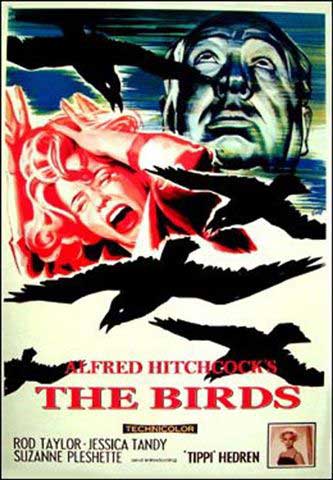
Evan Hunter (Ed McBain) scripted THE BIRDS. He fell out with Hitchcock over the rape scene in MARNIE (1964). The strangulation-rape in FRENZY (1972) shows Hitchcock unrestrained.

Barbara Leigh-Hunt in FRENZY
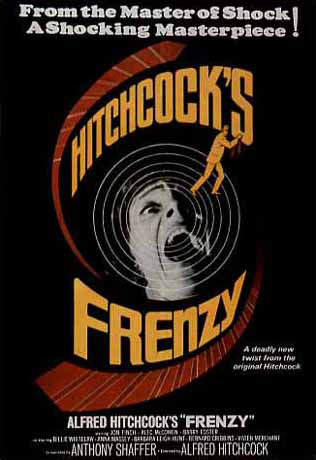
The calendar of crime is rife with murders spawned by sexual frustration. Rejected men who lash out with misogynous hatred. Was Jack the Ripper fueled by that emotion? In December 1989, Marc Lepine shot 14 women to death and wounded 10 at an engineering school linked to the University of Montreal. His suicide note blamed his rampage on "feminists, who have always ruined my life. I have decided to put an end to those viragos." In August 2009, George Sodini opened fire on a women's gym class in Pennsylvania, killing 3 and wounding 9. His note and blog roiled with rage at women for rejecting him.
Slade's courtroom career exposed similar motives. After work, he would jog the Joiner Trail, a 10 kilometer run in Stanley Park. One day, he got to prosecute a case linked to the trail. A man collecting empty bottles found skeletal remains in the bushes near the jogging path. Dental records identified the corpse as a teenage girl who'd vanished from nearby Second Beach a year before. Two men were arrested when one of them boasted about the murder to impress a motorcycle gang. He had lured the girl into the park for sex. When his buddy stepped out of the bushes and told her it was his turn, the teen balked. Enraged at being rejected, the spurned man smashed her skull with a rock. Both accused were sentenced to life imprisonment.
Years later, Slade defended a man who lived in a fantasy world. At an early age, he'd been misdiagnosed as "retarded." In fact, he was highly intelligent, but dyslectic. A broken home led to him being warehoused in various mental institutions for all but 3 of his 28 years. When he was finally released, he suffered from a severe personality disorder, combined with paranoia, psychosis, and neurosis. Obsessed with gaining fame, power, and having control over women, he was unable to separate fact from fantasy, or fantasy from delusion. Much like Mephisto.
A mother of three was working alone on an all-night shift at a convenience store. Police were called when the store was found empty at 4:30 a.m. The woman's purse containing ID and money was there. Six months later, a body unclad from the waist up was found in a shallow grave. Suspicion fell on the accused because of a prior incident. He had pulled a knife on a woman for unrequited love, telling her he had "raped women in the past, was good at hiding bodies, and could murder if he wanted." The police showed him photos of the burial site and asked him to imagine how she got there.
The accused stood trial for 1st degree murder. Psychiatrists agreed that he lived in the realm of make-believe, and told stories calculated to impress other people. His statements were unreliable unless corroborated by fact, and there were no forensic traces linking him to the body. The prosecutor theorized that he had taken the victim to the woods at knifepoint, and had killed her for rejecting him. Unable to decide whether his confession was fact or fantasy, the jury of eight women and four men acquitted him.
The next day, the man walked into the courthouse and asked to be tried again. The past trial was the highlight of his life. It gave him fame, power, and control over women.

THE FOUNTAIN OF YOUTH, by Eduard Veith

THE FOUNTAIN OF YOUTH, by Lucas Cranach the Elder, 1546
The Fountain of Youth is one of history's mythic quests. From time immemorial, people have sought means to restore their youth. "Youth is wasted on the young" is a proverb every middle-aged human understands. By far the most famous quest for the Fountain was 16th century Spanish explorer Juan Ponce de Leon's search in Florida.
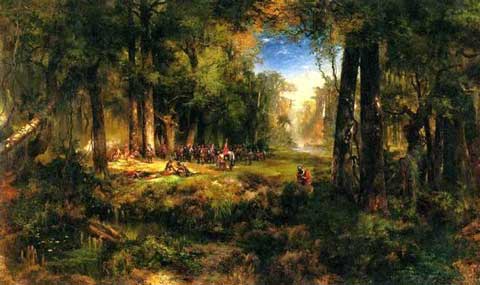
PONCE DE LEON IN FLORIDA, by Thomas Moran, 1878
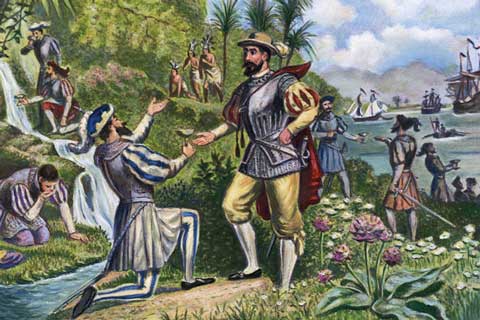
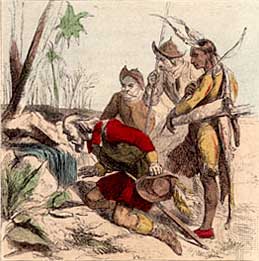
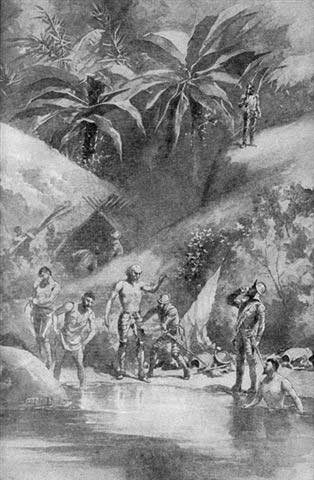
What forged these various pieces into the plot of DEATH'S DOOR was a comment that Slade overheard in a movie theater. Fittingly, the film was the remake of THE MUMMY (1999). Slade was munching popcorn, waiting for it to begin, when the woman seated behind him said to her girlfriend, "Forget about revitalizing mummies. Won't someone revitalize me!" That led to a lively discussion about "having work done." One woman desired a facelift and to have her nose reshaped. The other opted for liposuction on fatty parts. Both agreed their friend Betty would benefit from breast enhancement.
Then the movie started, and that got Slade thinking.
Would the Fountain of Youth not be ideal for the return of Mephisto? How many TV ads have you seen for anti-aging products: creams and balms that you should buy "because you're worth it"? How much is spent every year on cosmetic surgery? On nips and tucks? Baby Boomers are the Me Generation, and they rebel at going into the Golden Years without a fight. Also, consider the plight of Hollywood actresses over forty. Have you noticed how many aging male stars are teamed up onscreen with women young enough to be their daughters? And in some cases, their granddaughters!
The flip side of the Fountain of Youth is the Fountain of Age. "The years shall run like rabbits..." wrote W.H. Auden in "I Walked Out One Evening" (one of Slade's favorite poems), and time is sped up horrifically for those who suffer from the aging disease of progeria.

Progeria
What if an Egyptian mummy were found preserved in perfect condition? How would Mephisto's obsession with the Fountains of Youth and Age convert that discovery into a psychotic mass murder scheme? The Internet is a link-up boon for sexual predators and nihilistic terrorists. Through it, he assembles a team of diabolical henchmen. Stopwatch is a rogue mercenary who will pull off any heist if the price is right. He does it for the thrill of the kill, and to prove he's the best. The Doctor is plagued by the Hitchcock Syndrome. He's a whiz at revitalizing fading Hollywood stars, and Mephisto offers him release from sexual repression. If he will partake in surgical experiments on a private island off the coast of the Pacific Northwest, undertaken in secret vaults beneath the Panacea Clinic, he'll never be rebuffed by another ungrateful woman.
In the studio days of Hollywood, there was the "casting couch." Fat moguls puffing cigars had their way with ingenues yearning to be stars. Legend says the name of the Raelettes - the background vocalists of Ray Charles - was a not-so-subtle play on his notorious infidelities - that is, they had to "let Ray."
So if the Doctor rejuvenates aging Hollywood stars, is it too much to ask that they show their appreciation to that ugly little man? If they don't, they end up down in the vaults of Mephisto's House of Pain, where his resident Dr. Moreau is making monsters, not humans.

Guess which victim came to the Panacea Clinic for "face work," then refused to pay the Doctor's bill? And which came for "breast enhancement," then rebuffed the Doctor's clumsy seduction? And which came for "liposuction," then laughed in the Doctor's face?
The ghoul who cleans up the mess behind Death's Door is the Undertaker. The motherless son of a funeral director, he used to haunt the embalming room and caress the cold corpses. Before they were buried or cremated, he harvested memento moris of their time together. The trophies are his personal mummy collection.
By night, the Undertaker dumps the Doctor's monsters on the beaches of West Coast islands. There, they'll be found by San Juan County sheriff's deputies or the Mounties of Special X.
Mephisto's a megalomaniac. No one thwarts him and gets away with it. Sheriff's deputy Jenna Bond did in BURNT BONES, so that's why her kidnapped daughter is locked in a cage in Mephisto's House of Pain. His prime target, however, is Chief Supt. Robert DeClercq. And the Mountie's lover, Dr. Gill Macbeth, has just checked into the health spa at the Panacea Clinic on Mephisto's version of the Island of Dr. Moreau.
The Doctor is watching her every move through the one-way mirror in her room.
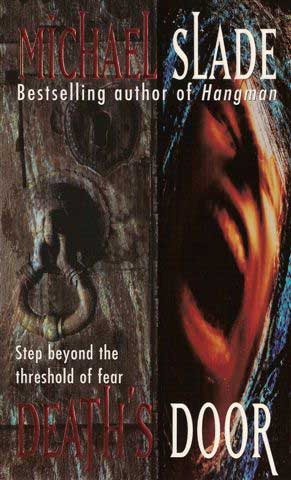
Canadian edition of DEATH'S DOOR
"WHEN ART IMITATES LIFE. Bestselling author Michael Slade has turned real life cops into serial killer hunters in DEATH'S DOOR. And the cops love it. You'd be hard-pressed to find many women who'd delight in having their real life play out in the pages of a Slade thriller. Slade's whodunits feature sadistic psychopaths who take blood-splattered pleasure in hunting humans. In turn, the Mounties use 21st century sleuthing to hunt the psychopaths. RCMP Staff Sergeant Christine Wozney is the second real life cop to be used as a character in a Slade novel. Detective Inspector Kim Rossmo, the inventor of Geographic Profiling, was the first. Initially, Slade went to see Wozney to get a sense of what kind of woman had climbed to the top in the testosterone-charged RCMP environment. For Wozney, the head of ViCLAS - the Violent Crime Linkage Analysis Section - on the West Coast, the flights of frightful fantasy in Slade's psycho thrillers simply represent fictional accounts of all-too-real events. And she should know. Wozney: 'There may be a lot of things in Slade that you'll read and go, "Oh my goodness, they don't really do that to people, do they?" I can tell you, yes, they do.'" - The Outlook
"DEATH'S DOOR is a Grade A thriller. I've never encountered a book that fostered such wildly divergent and irreconcilable responses. Slade has finely honed his thriller skills: good use of West Coast locations, twisted, near-omnipotent villains, brutal violence, sharp plot twists, solid (and enthralling) historical research, the latest in high-tech crime-fighting techniques - it's all here. Slade is the bastard child of Sherlock Holmes and the Marquis de Sade, plotting his thrillers like the Saturday afternoon movie serials of the 1930s and 40s. Cliffhanger rushing headlong into cliffhanger. DEATH'S DOOR succeeds admirably. It's an impressive thriller. You'll be up all night reading it and, before you finally sleep, you'll check under the bed." - The Vancouver Sun.
"There are psycho thrillers and there are psycho thrillers, and the ones to watch are those by Michael Slade. This high-powered mystery stars a psycho so heinous that one critic claims he makes Hannibal Lecter look like an Oxford don with slightly unorthodox culinary tastes. Adding more than a specter of realism to Slade's books is the fact that his real-life experience as a trial lawyer specializing in cases for the criminally insane is steeped in murderous interludes. You might want to take a deep breath before starting this seemingly baffling case for C/Supt. Robert DeClercq. Here's a story to be read with caution." - The Ottawa Citizen
"MASTER OF THE NORTHERN GIALLO. There are more than a few reasons to take the stand and scream the glories of literary demon Michael Slade. There just isn't a precedent for the barbaric brilliance of a Slade novel. With its well-researched, candid ventures into not only the most deranged of sick psyches, but the internal workings of the Royal Canadian Mounted Police as well, DEATH'S DOOR is a witches' brew of intense intellectualism, police procedure, and white-knuckle, wince-inducing gore." - Rue Morgue

Polish edition of DEATH'S DOOR
Sometimes, life imitates art.
Between August 20, 2007 and November 11, 2008, seven severed human feet and an eighth hoax were found on the beaches of West Coast islands in British Columbia and Washington State, in the same area as the mutilated corpses in DEATH'S DOOR (2001).
Jedediah Island, August 20, 2007, a man's right foot in a shoe.
Gabriola Island, August 26, 2007, a man's right foot in a shoe.
Valdez Island, February 8, 2008, a man's right foot in a shoe.
Kirkland Island, May 22, 2008, a woman's right foot in a shoe.
Westham Island, June 16, 2008, a man's left foot in a shoe (the match to February 8).
Juan de Fuca shore, August 1, 2008, a man's right foot in a shoe.
Fraser River, November 11, 2008, a woman's left foot in a shoe (the match to May 22).
As you'd expect, the parallel to DEATH'S DOOR was picked up by the papers, networks, and Newsweek.
One foot was identified, but not the others, and the case remains unsolved.
Mephisto?














